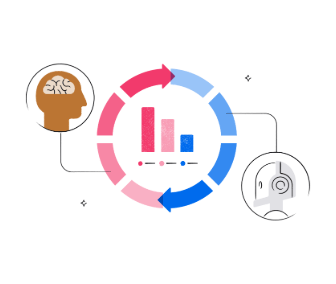3 key ways academic research methods are changing in 2026
By Laura Ojeda Melchor●7 min. read●Dec 15, 2025

The phrase “unprecedented” has become overly precedented in academic research circles this year. From lightning-fast technological advances to overnight funding disruptions to ongoing recruiting challenges, research teams at higher ed institutions have had to contend with several concurrent changes.
Three major trends stand out as change agents in 2025. First, the proliferation of AI is impacting how research gets done. Second, federal and state funding sources are undergoing rapid shifts due to broader policy changes. And third, quantitative and qualitative research projects are converging as technology evolves.
Here’s what the landscape looks like today — and how research teams can embrace these changes to uncover new opportunities to refine their methods for the future.
1. Proliferation of AI
A few years ago, generative AI was a newborn baby that everyone was afraid to hold and didn’t quite know what to do with. But it’s 2025 now, and our personal and work lives are beginning to revolve around this exciting technology.
Personal use of AI is taking off. In September 2025, research conducted by Duke University, Harvard University, and OpenAI estimated that roughly 10% of the world’s adult population now uses generative AI tools.
One reason AI usage is increasing so fast? It’s being incorporated into ubiquitous internet tools. Google now has AI Overviews that appear above traditional search engine results, offering up information immediately. And AI Mode takes the evolution one step further, using its Gemini large language model (LLM) to answer text, voice, and image search queries.
On the academic side, AI is making research more accessible to broader audiences. Tools like Google Scholar now offer AI summaries of academic PDFs. And AI-powered search engine Perplexity gathers information from research sources and offers users a tidy summary and source list.
AI is also shaking up academic research methods by:
Making it easy to automate literature reviews. Literature review can be tedious, but AI tools like Elicit and ResearchRabbit make it much easier to identify and screen relevant papers, extract data, and synthesize findings. AI tools can even take a first stab at full literature reviews, leaving researchers with more time for high-value tasks like study design and analysis.
Giving synthetic data a role. In response to data privacy constraints, data access challenges, and cost pressures, some researchers are starting to use synthetic data to augment or even replace traditional datasets. While synthetic data is still in its infancy, teams have found value in using it for scenario simulations and sample boosting.
Shifting the role of the researcher. As parts of the research process become more automated, the role of the academic researcher is evolving. Teams are spending less time on basic ops tasks and more time designing AI-augmented workflows, interpreting results, and applying human judgment to ensure quality results.
Opportunity: Evaluate AI tools and datasets, look for ways AI can support your projects, and train your research team on how to use AI technologies effectively and responsibly.
2. Rapid shifts in federal and state funding
This year has rocked higher ed research budgets in unpredictable ways. After years of pandemic-era boosts and one-time federal programs, 2025 brought a wave of substantial recalibration.
According to STAT News, new budget documents show that the National Institutes of Health (NIH) could see research funding drop by up to 43%, meaning roughly 1,800 fewer new grants in 2026. That’s one of the biggest proposed cuts in NIH history, and its effects are already rippling through labs across the country.
The National Science Foundation (NSF) is also tightening its rules, signaling new limits on indirect cost recovery, which covers essentials like lab space, compliance staff, and utilities. The Department of Defense followed suit earlier this year, issuing guidance that caps indirect rates at 15% for new awards to universities.
And it’s not just federal funding. States are adjusting their own spending as budgets shift. An analysis by Center for American Progress found that many state university systems are losing hundreds to thousands of dollars per student in both federal and state support. This means fewer dollars to support new research, fellowships, and innovation initiatives.
Opportunity: Review your in-flight and planned research projects and explore creative ways to do more with less. Some programs are turning to open data sources, shared facilities, and microgrants to bridge budget gaps in the short term.
3. Evolution of quantitative vs. qualitative research
For decades, research has been split cleanly between quantitative and qualitative studies. But in 2025, those lines are becoming blurred.
This is partially because quantitative research is under constant pressure. Issues with data quality, participant fatigue, and rising costs are making researchers rethink when and how they field large-scale surveys to gather insights.
At the same time, qualitative research is getting a tech upgrade. Digital ethnography, or the study of people through the online worlds they inhabit, is growing through forums like Reddit and Quora and social communities like TikTok, Facebook, and LinkedIn.
Digital ethnography makes it far easier to collect insights about online audiences — insights that once could only be gathered with quantitative surveys. And with how easy it is to conduct remote interviews and focus groups, gathering qualitative data from non-digital communities is easier than ever.
New AI-powered qualitative data analysis (QDA) tools like NVivo and Atlas.ti can also speed up tedious coding steps, making it easier for researchers to review and synthesize qualitative data on a larger scale.
Opportunity: Consider new ways of combining quant and qual methods for your upcoming research projects. For ongoing projects, put safeguards in place to ensure quantitative data is high-quality and actionable, and look into new tools that can help you get more value out of qualitative data sets.
Keys to successful academic research in 2025 and beyond
So how do academic research teams keep making progress when everything feels like it’s in flux?
Automate what you can. AI tools can now handle time-intensive tasks like literature reviews, data cleaning, and survey analysis. It can also speed up the review process for fraud prevention workflows during recruiting, fielding, and analysis.
Mix your methods. Leading academic research teams are combining techniques, pairing surveys with interviews or using synthetic data alongside human insights. This helps teams get a fuller picture faster — and makes budgets go further.
Protect quality and transparency. AI brings efficiencies, but it also introduces new quality and transparency challenges. Document your methods clearly, track data sources, and audit for potential bias.
Diversify your funding. When national grants slow down, look beyond federal dollars. Many labs are turning to microgrants, open datasets, and shared infrastructure to help keep projects moving.
Keep learning and adapting. The most successful research teams will continue to do what they’re best at: lean into change and engage with curiosity and openness.
With the right tools, teamwork, and adaptability, 2025 can mark the start of a more creative and efficient era for academic research.


